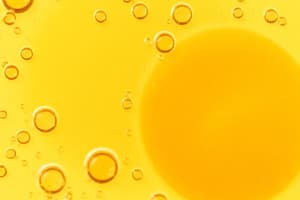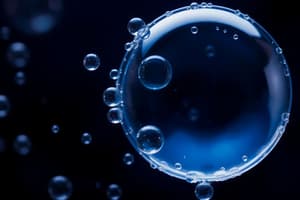Podcast
Questions and Answers
What characteristic feature is common to all surfactants?
What characteristic feature is common to all surfactants?
- They always form a rigid film at interfaces.
- They consist of both polar and non-polar portions. (correct)
- They have a single hydrophobic portion.
- They are exclusively polar molecules.
How do ionic surfactants primarily stabilize oil-in-water emulsions?
How do ionic surfactants primarily stabilize oil-in-water emulsions?
- By creating rigid films that prevent coalescence.
- By forming complex structures with the oil droplets.
- By absorbing energy from the oil.
- Through electrical repulsion between charged particles. (correct)
What role does the hydrophilic portion of a surfactant play?
What role does the hydrophilic portion of a surfactant play?
- It absorbs UV light to protect the emulsion.
- It increases the viscosity of the solution.
- It interacts with non-polar substances.
- It facilitates interaction with water. (correct)
Which of the following surfactants is likely to stabilize oil-in-water creams?
Which of the following surfactants is likely to stabilize oil-in-water creams?
What happens to an emulsion when the surfactant film is disturbed?
What happens to an emulsion when the surfactant film is disturbed?
Which factor primarily determines the quality of the emulsion produced by surfactants?
Which factor primarily determines the quality of the emulsion produced by surfactants?
What type of emulsion do charged surfactants generally promote?
What type of emulsion do charged surfactants generally promote?
What is a problem associated with using charged surfactants in oral emulsions?
What is a problem associated with using charged surfactants in oral emulsions?
What is the primary role of finely divided solids in emulsion stabilization?
What is the primary role of finely divided solids in emulsion stabilization?
According to the preferential wetting theory, which type of emulsion is formed by particles that are preferentially wetted by water?
According to the preferential wetting theory, which type of emulsion is formed by particles that are preferentially wetted by water?
According to the Bancroft rule, what determines the type of emulsion formed?
According to the Bancroft rule, what determines the type of emulsion formed?
Which of the following is a characteristic of hydrophilic colloids used as emulgents?
Which of the following is a characteristic of hydrophilic colloids used as emulgents?
What effect do macromolecules like proteins and gelatin have on emulsions?
What effect do macromolecules like proteins and gelatin have on emulsions?
Which statement correctly describes emulsifying agents with a high HLB value?
Which statement correctly describes emulsifying agents with a high HLB value?
What is a potential problem when using hydrophilic colloids in emulsions?
What is a potential problem when using hydrophilic colloids in emulsions?
In terms of emulsion types, what is the defining factor for finely divided solids that result in water-in-oil emulsions?
In terms of emulsion types, what is the defining factor for finely divided solids that result in water-in-oil emulsions?
What is the primary function of emulsifying agents in emulsions?
What is the primary function of emulsifying agents in emulsions?
Which property is essential for an emulsifying agent to effectively stabilize an emulsion?
Which property is essential for an emulsifying agent to effectively stabilize an emulsion?
What type of system is indicated when oil is the continuous phase and water is dispersed?
What type of system is indicated when oil is the continuous phase and water is dispersed?
Which of the following can be used to classify emulsifying agents based on their source?
Which of the following can be used to classify emulsifying agents based on their source?
What type of film is produced at the interface of particles in emulsions using hydrophilic colloids?
What type of film is produced at the interface of particles in emulsions using hydrophilic colloids?
What effect does adding a third component have on emulsions?
What effect does adding a third component have on emulsions?
Which of the following is NOT a desired property of an effective emulsifying agent?
Which of the following is NOT a desired property of an effective emulsifying agent?
When selecting emulsifiers, which factor related to cost must be considered?
When selecting emulsifiers, which factor related to cost must be considered?
Which system is indicated when emulsions are capable of conducting electric current, especially with ionic surfactants?
Which system is indicated when emulsions are capable of conducting electric current, especially with ionic surfactants?
What phenomenon occurs when droplets in an emulsion aggregate or combine, leading to instability?
What phenomenon occurs when droplets in an emulsion aggregate or combine, leading to instability?
Flashcards
Surface Active Agent (SAA)
Surface Active Agent (SAA)
A substance that lowers surface tension at the interface between two immiscible liquids, like oil and water, forming a monomolecular film.
Amphiphile
Amphiphile
A molecule with both a hydrophilic (water-loving) and a hydrophobic (water-fearing) part.
Hydrophilic group
Hydrophilic group
The part of a surfactant molecule that is attracted to water.
Hydrophobic group
Hydrophobic group
Signup and view all the flashcards
Ionic surfactant
Ionic surfactant
Signup and view all the flashcards
Steric repulsion
Steric repulsion
Signup and view all the flashcards
Electrical repulsion
Electrical repulsion
Signup and view all the flashcards
Anionic surfactant
Anionic surfactant
Signup and view all the flashcards
Solid Emulsifiers
Solid Emulsifiers
Signup and view all the flashcards
Preferential Wetting Theory
Preferential Wetting Theory
Signup and view all the flashcards
Bancroft Rule
Bancroft Rule
Signup and view all the flashcards
HLB Value
HLB Value
Signup and view all the flashcards
Hydrophilic Colloids
Hydrophilic Colloids
Signup and view all the flashcards
Methylcellulose
Methylcellulose
Signup and view all the flashcards
O/W Emulsion
O/W Emulsion
Signup and view all the flashcards
Macromolecules
Macromolecules
Signup and view all the flashcards
Liquid-Liquid System (LLS)
Liquid-Liquid System (LLS)
Signup and view all the flashcards
O/W System
O/W System
Signup and view all the flashcards
W/O System
W/O System
Signup and view all the flashcards
Emulsion
Emulsion
Signup and view all the flashcards
Emulsifying Agent
Emulsifying Agent
Signup and view all the flashcards
Interfacial Tension
Interfacial Tension
Signup and view all the flashcards
Film Formation (Emulsification)
Film Formation (Emulsification)
Signup and view all the flashcards
Finely Divided Solids (Emulgent)
Finely Divided Solids (Emulgent)
Signup and view all the flashcards
Hydrophilic Colloids (Emulgent)
Hydrophilic Colloids (Emulgent)
Signup and view all the flashcards
Study Notes
Emulsions - Pharmaceutical Liquid-Liquid Systems
- Emulsions are liquid-liquid systems where one liquid is dispersed as droplets within another liquid
- Two immiscible liquid phases are involved; internal phase (dispersed), external phase (dispersion medium)
- Oil-in-water (o/w) systems have oil droplets dispersed in water
- Water-in-oil (w/o) systems have water droplets dispersed in oil
Learning Objectives
- Students should be able to explain liquid-liquid system formulation principles and their use in pharmaceutical products
- They should be able to apply the HLB concept to formulate oil-in-water and water-in-oil emulsions
- Students should be able to discuss various mechanisms of emulsion instability and strategies for improving stability
Pharmaceutical Use of LL Systems (Topical)
- Topical products include creams and lotions, both medicated and non-medicated
- These products can be anti-inflammatory, antibacterial, antifungal, moisturizing, and/or cosmetics
- Available as aqueous-based, oily, semi-solid, and liquid formulations.
Injectable LLS Products
- Intravenous (IV) lipid emulsions (o/w) are used as a nutritional energy source, providing essential fatty acids and triglycerides
- Intramuscular and subcutaneous injections can use w/o or o/w emulsions for delayed/controlled release
- Sterility is crucial for injectable products
- Particle size must be small (e.g., 100-200 nm) for optimal delivery.
Oral LLS Products
- Emulsions are used for poorly water-soluble drugs, such as cyclosporine, griseofulvin, and steroids
- Dissolving the drug in the oil phase prevents the rate-limiting step of solid-phase dissolution, and enhances absorption
- Emulsifiers present changes in biochemical and physical barriers
- Larger volumes, poor taste, and patient compliance can be issues. Ideal systems can be placed in capsules.
Liquid-Liquid Systems - Definitions
- Immiscible liquids form a dispersed system when one liquid is dispersed as globules in the other
- The dispersed phase is the internal phase
- The dispersion medium is the external phase
- Quiz: Blue is water, red is oil, what LLS type does the diagram show? How is this checked?
Identifying w/o or o/w systems
- Diluting with water helps identify the external phase
- Conductivity is checked with a meter to evaluate ionic surfactants (important for o/w systems); o/w systems conduct electricity better
- Color tests use water-soluble dyes; if dye dissolves, water is the continuous phase. (o/w).
- Feel: Creamy/greasy texture points to w/o systems; o/w emulsions have a different feel
Emulsification
- Emulsions are unstable due to immiscible phases, large interfacial areas, and high interfacial free energy; collisions lead to flocculation, coalescence, cracking, and separation of phases
- Emulsification is stabilized by the addition of a third component - an emulsifying agent
- Emulsifiers improve stability by reducing the interactions between the two phases
Desired Properties of an Emulsifier
- Quickly adsorb to the internal phase
- Form a stable, coherent film
- Provide a mechanical barrier.
- Reduce interfacial tension to prevent coalescence
- Have electrical potential on droplet surface
- Improve viscosity
- Work effectively at low concentrations
- Be non-toxic
- Be non-irritating
- Be non-interacting (with other components).
- Be inexpensive
Classification of Emulsifiers
- Traditionally classified by source (animal, vegetable, mineral, synthetic).
- Examples include wool fat, acacia, calcium hydroxide, bentonite, and surfactants.
Type of Film Produced
- Finely divided solids form particulate films
- Hydrophilic colloids form multi-molecular films; these require a film to break for drug release
- Surface active agents (SAAs) form mono-molecular films
- SAAs are necessary for the stability of the film
Preferential Wetting Theory
- Finely divided solids are wetted by both oil and water to some degree
- Particles preferentially residing in the liquid form the external phase
- Water wetted particles define o/w; oil wetted particles define w/o emulsions
Bancroft Rule
- The phase where the emulsifier is more soluble is the external phase
- High HLB values favor o/w emulsions (hydrophilic); low HLB values favor w/o (lipophilic).
Hydrophilic Colloids and Macromolecules as Emulsifiers
- These form strong, multi-molecular films, preventing coalescence
- Drug release necessitates film breakdown, potentially causing problems for absorption/bioavailability.
- Example molecules include methylcellulose, modified starches, pectin, alginates, proteins, gelatin, egg yolk, lecithin, and gums.
Surface Active Agents (SAAs)
- SAAs decrease surface tension by adsorbing at the oil-water interface
- SAAs form complex, flexible, and condensed films at the interfaces, preventing disruption and facilitating rapid reformation of the film after stress.
- SAAs can reside at the interface due to their amphiphilic nature; one polar part and one non-polar part.
Characteristic feature of ALL surfactants – Amphiphilic
- Surfactants have one polar (hydrophilic) portion and another nonpolar (hydrophobic) portion
- The relative size and characteristic nature of polar and nonpolar portions determines the emulsion type and quality
SAA Examples
- Examples of SAA include sodium lauryl sulfate, cetrimide, cetostearyl alcohol, polyoxyethylene sorbitan mono-oleate, and dodecylamine.
- Hydrophilic groups involve sulfate groups, quaternary ammonium compounds, and polyoxyethylene chains.
- Hydrophobic groups involve alkyl acids, alcohols, amines, and hydrocarbon-based fatty acid chains.
How Do SAAs Stabilize an Emulsion?
- Electrical repulsions occur via ionic surfactants; cationic and anionic groups.
- Steric repulsions occur through non-ionic surfactants.
Ionic Surfactants
- Tend to promote o/w emulsions because water is the preferred medium for ions
- Produce o/w creams and lotions
- Typically not used in oral emulsions (laxative effect may occur)
Anionic Surfactants
- Formed from fatty acid salts (soaps) through reaction with univalent or divalent alkali
- Aqueous emulsions stabilize with sodium oleate
- Oily emulsions stabilize with calcium oleate
- In acidic pHs, can precipitate out as free fatty acid
- More stable in alkaline medium; incompatible with cationic drugs.
Cationic Surfactants
- Formed through reaction of fatty amines with salts, as in cetrimide
- Used in antiseptic creams, due to its antimicrobial properties.
- More irritating than anionic or non-ionic surfactants. Often used in hair conditioners and fabric softeners.
Non-Ionic Surfactants
- Non-charged/negligible charge, e.g. cetomacrogol
- Wide range of compatibility
- Generally non-toxic & non-irritating
- Less sensitive to temperature/electrolytes/pH changes
- Used in foods, drinks, pharmaceuticals, and skin-care products; suitable for parenteral products
- Hydrophobic moieties involve fatty acids/alcohols (C12 - C18)
- Hydrophilic moieties consist of alcohol/ethylene oxide chains
Sorbitan Esters (Spans®) and Polysorbates (Tweens®)
- Produced by esterification of the hydroxyl groups of sorbitan with fatty acid
- Spans are lipophilic and create w/o emulsions
- Tweens are hydrophilic and create o/w emulsions. Often paired.
Other Specialized Surfactants - Such as Lecithin
- Contain both hydrophilic and non-hydrophilic properties.
- The charge is affected by pH levels (cationic at low pH, anionic at high pH)
- Examples include lecithin, and betaine.
Emulgent System
- Combinations of emulsifying agents for stability, often pairing a hydrophilic tween and a hydrophobic span.
Emulsion Stability
- The stability of a dispersed system is affected by the input of energy, and factors like large interfacial area
- Methods for decreasing particle size include mortars, pestles, homogenizers, and ultrasonicators; IV emulsions tend to use smaller particle sizes.
Emulsion Stability – Energy Barrier
- Emulsions are fundamentally high-energy systèmes; there is a constant desire to reduce the free energy state, and thus the interface
- The energy barrier protects the formulation stability
- Energy must be put into the system to prevent phase separation
Emulsion Instability – Summary
- Emulsions are highly unstable, and thus stability needs to be promoted and maintained.
- Instability involves various changes such as flocculation, creaming, coalescence, cracking, and phase inversion (which can affect the overall emulsion type from o/w to w/o)
- Factors include phase volume ratio, droplet size, chemical and physical incompatibilities, and storage temperatures
Mechanisms of Emulsion Instability
- Flocculation - aggregation of droplets without losing individual identity. Weak associations.
- Creaming - separation by density differences, with the higher-density component migrating to the top or bottom of the emulsion. Reversible with shaking
- Coalescence - merging of droplets and is an irreversible process
- Cracking - Complete phase separation; not reversible
- Phase inversion - change in emulsion type; for example from o/w to w/o
Creaming vs. Sedimentation
- Creaming is the upward movement of internal phase droplets
- Sedimentation is the downward movement of internal phases (a "negative" creaming)
Coalescence and Cracking
- Coalescence is the merging of droplets to form larger droplets.
- Cracking leads to complete separation of the two liquids.
Phase Inversion
- A change in the emulsion type (o/w to w/o); it is often seen when more internal phase or other factors are added to the system.
- The nature of the interfacial film can change due to the addition of salts/chemicals
- Temperature effects can also cause phase inversion
Temperature Effects
- The HLB values of SAA are sensitive to temperature. Higher temperatures mean more likely a lower effective HLB value; this impacts the emulsification type
- Phase inversion temperature (PIT) is characteristic for particular SAAs; this helps with the heating/cooling processes
- Emulgent concentrations can also affect the emulsion type, as higher values typically favor o/w
Preservatives in L-L Systems
- The preservative needs to penetrate bacterial membranes and must exist in an un-ionized state
- Partitioning of preservatives between oil and aqueous phases occurs and must be considered
- The preservative concentration should suffice to maximize its effect in the aqueous phase; the microbial growth often happens in aqueous solutions
Preservative Effectiveness
- pH affects preservative behavior: certain preservatives are only effective at a particular pH
- Some SAAs can hinder preservative effectiveness
- Factors such as emulsion type, nutraceutical qualities, and aeration conditions have to be taken into consideration.
Microemulsions
- Microemulsions are emulsions with very small particle sizes (colloidal).
- Typically homogenous, translucent, and low viscosity systems are favored
- The particle size of the dispersed phase impacts its physical characteristics, and the SAA needed changes depending upon the droplet sizes
- Increased surfactant concentrations are needed to stabilize the emulsion with very small droplets.
Useful as Drug Delivery Systems
- Microemulsions/emulsions/SEDDS can be used to increase drug bioavailability by delivering poorly water-soluble drugs in the internal phase
- This technology is now applied to transdermal, ocular, IV, and oral systems
- Currently used in cosmetics, food, and industrial processes.
SEDDS and SMEDDS
- Self-emulsifying drug delivery systems rely on isotropic oil/surfactant/co-solvent mixtures; they need dilution in aqueous GI fluids to form stable emulsions
- Enhance oral bioavailability of lipophilic drugs (e.g., cyclosporine, vitamins, ibuprofen).
- Uniform drug absorption and plasma levels are seen, and these systems protect against drug degradation and gastric irritation.
- Potential problems exist due to high surfactant concentrations (irritation, toxicity, tissue damage)
Multiple Emulsions (w/o/w etc)
- Multiple emulsions contain complex structures, with one phase encased within another phase (w/o or o/w)
- The presence of oil layers between phases acts as a rate-controlling membrane between aqueous phases.
- Lower viscosity and easier injection results. Examples include delayed-action drug systems.
Practice Questions
- Liquid-liquid systems (LLS) are inherently unstable - True (they require continual effort to maintain their status). Discuss the reasons.
- Three mechanisms of instability include: flocculation, creaming, and coalescence - these and other techniques/approaches can help to minimize the instability
- The choice of emulsifiers and the manufacturing method can impact stability. The manufacturing method choice affects droplet size, viscosity, and other factors.
- Creams/lotions are often labelled for storage below a certain temperature to minimize instability; temperature affects HLB values for example.
Studying That Suits You
Use AI to generate personalized quizzes and flashcards to suit your learning preferences.


![Pharmaceutical Engineering: Surfactants I [PHENt 203]](https://images.unsplash.com/photo-1580982172477-9373ff52ae43?crop=entropy&cs=srgb&fm=jpg&ixid=M3w0MjA4MDF8MHwxfHNlYXJjaHw1fHxzdXJmYWN0YW50cyUyQyUyMHBoeXNpY2FsJTIwcGhhcm1hY3klMkMlMjBwaGFybWFjZXV0aWNhbCUyMGVuZ2luZWVyaW5nfGVufDF8MHx8fDE3MTgxODE0MjJ8MA&ixlib=rb-4.0.3&q=85&w=300&fit=crop&h=200&q=75&fm=webp)

